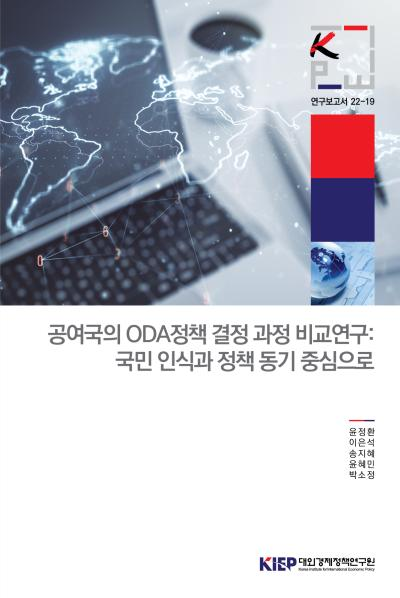Working Papers
PUBLISH
Working Papers
To list

A Comparative Study on ODA Policy Process: Public Awareness as a Policy Motive
ODA, Foreign aid
Author Jeonghwan Yun, Eunsuk Lee, Jihei Song, Hyemin Yoon, and Sojeong Park Series 22-19 Language Korean Date 2022.12.30
For a decade since joining the OECD DAC in 2010, Korea’s ODA saw immense improvement in terms of its scale, governance structure, and strategy. This was efficiently achievable through a process of fast-following the examples provided by leading global donors. However, such condensed development of institutions was insufficient to ensure the holistic improvement of all related governance systems. Especially, the policies and strategies for public relations were deemed of secondary importance, compared to the urgency of governance directly related to proper delivery of the aid. For Korea to further contribute to the global society as a leading donor, it has become essential to clearly elaborate its long-run ODA policy based on solid policy motives to support it.
In this study, we revisit one of the most important intrinsic policy motives: the public awareness on development cooperation, and where it lies in Korea’s ODA. To elaborate the current status and potential roles of public opinion regarding the current ODA system, we conduct comparative analyses with other donors to define the main challenges for Korea. Furthermore, we conduct individual level empirical analyses using harmonized survey data accumulated over 11 years, and propose a strategy to enhance public awareness in Korea.
In chapter 2, we first quantitatively assess the levels of correspondence between Korea’s ODA and public awareness. We find some economic outcomes agree with the public awareness on the economic importance of ODA. However, from other outcomes of our interest, such as scale, resource allocation, and policy goals, we find vast discrepancy between public perceptions of ODA and the actual administration of ODA programs. Thus, we raise the need for enhancing a strategy regarding public relations.
In chapter 3, we present examples of a strong governance system and concrete strategy for public relations within other donor countries. We exemplify these public relations strategies in two categories: 1) channels to ensure public opinion is accurately reflected in ODA policy, such as coordination with the civil society, and 2) efforts to enhance the public awareness and understanding, such as Education for Sustainable Development (ESD).
The first section presents a taxonomy on the ODA policy making process. We elaborate the role of each stakeholder, including the civil society, and how their voice contributes to ODA policy making. The recent reform in the British ODA system and its communication throughout the reform process exemplify the importance of public opinion in ODA policy.
The second section of the chapter documents public awareness in the selected donor countries and their strategies. Their ODA institutes had a well established goal and curriculum. The curriculum was designed to provide an interactive learning opportunity on development cooperation, and various entities from both the public and private sector collaborate to provide such opportunities through formal and informal education. Public relation efforts through ESD strategies within these selected countries provide an important implication to Korea.
Chapter 4 scrutinizes the current status of public awareness in Korea, based on 11 waves of individual level survey data. The first half of the chapter documents the dynamic pattern of public awareness, including level of support for ODA. While the aggregate level of support was not dramatically lower then those of the countries examined in Chapter 3, most of this support was composed of rather lukewarm support for Korea’s ODA contribution. This finding implies that high awareness and support from the public are less likely to be a result of strategic effort, and more likely to originate from the generosity and goodwill of the people.
Based on the findings outlined above, the latter half of the chapter is devoted to discussing and suggesting a valid public awareness strategy for Korea. We exploit the results of our “Public Awareness for Development Cooperation Survey 2022,” designed and conducted specifically for this study. Underwhelmingly, we found lukewarm supporters tended to respond only to graphic descriptions of the hardships in developing countries designed for “emotional appeal.” However, we also identified an encouraging result on how even those lukewarm supporters with previous experience with ESD, as well as those who trust international organizations or partner countries, still respond to articles with “factual descriptions” of the current situation. Such a complementary effect shows how trust towards the partner country and global players provide the crucial social capital that the majority of the public lack of, and therefore should be slowly fostered by providing them with more opportunities for ESD. This finding echos with the survey result where 74% of our respondents answered they above all “wished to know whether Korean ODA did contribute to better lives in the recipient country.”
This study illustrates the urgent need for Korea’s ODA to establish public trust. Such a challenge requires to be tackled by strengthening partnerships with the civil society, and substantiate the communication channels within Korea’s ODA governance system. Additionally, more ESD opportunities should be provided through both formal and informal education systems. While the government should take a strong initiative on designing detailed curriculum and mobilizing resources, cooperation between ministries and agencies is crucial, and a stronger partnership with resourceful private sector entities, such as CSOs, is likely to help effective implementation.
Sales Info
| Quantity/Size | 258 |
|---|---|
| Sale Price | 12 $ |
 공공저작물 자유이용허락 표시기준 (공공누리, KOGL) 제4유형
공공저작물 자유이용허락 표시기준 (공공누리, KOGL) 제4유형
대외경제정책연구원의 본 공공저작물은 "공공누리 제4유형 : 출처표시 + 상업적 금지 + 변경금지” 조건에 따라 이용할 수 있습니다. 저작권정책 참조
